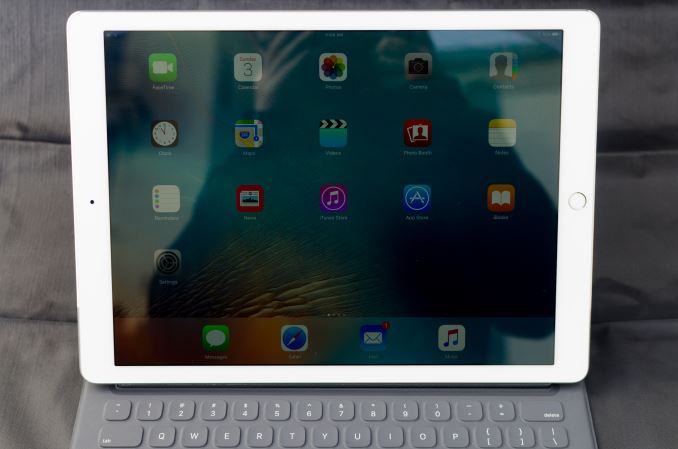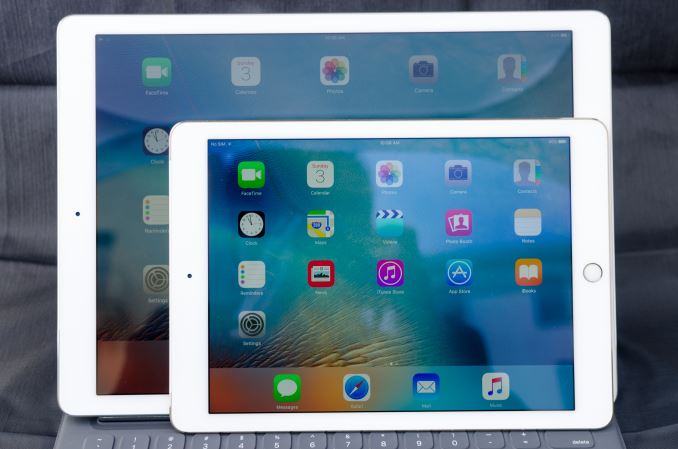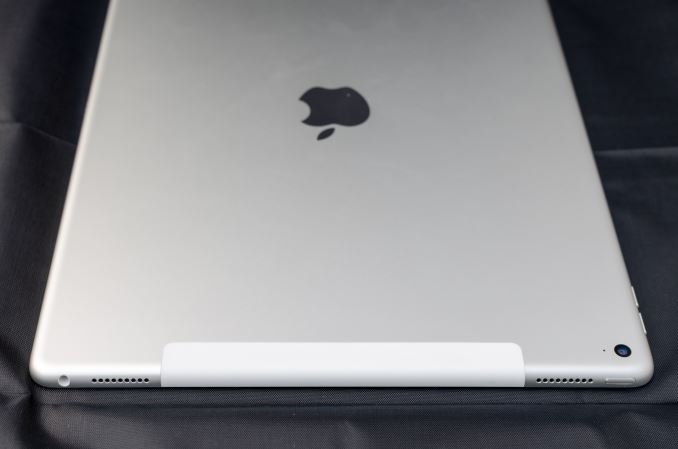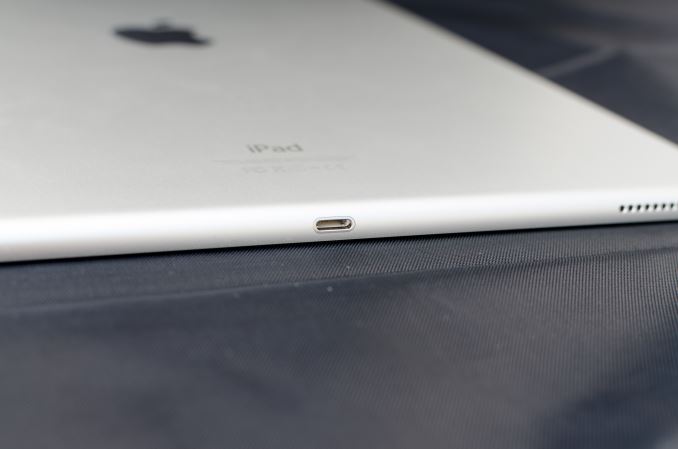The Apple iPad Pro Review
by Ryan Smith, Joshua Ho & Brandon Chester on January 22, 2016 8:10 AM EST
At this point it probably isn’t a secret that tablet sales have leveled off, and in some cases they have declined. Pretty much anywhere you care to look you’ll see evidence that the tablet market just isn’t as strong as it once was. It’s undeniable that touch-only tablets have utility, but it seems that the broader market has been rather lukewarm about tablets. I suspect at least part of the problem here is that the rise of the phablet has supplanted small tablets. Large tablets are nice to have, but almost feel like a luxury good when they’re about as portable as an ultrabook. While a compact laptop can’t easily be used while standing, or any number of other situations where a tablet is going to be better, a compact laptop can do pretty much anything a touch-only tablet can. A laptop is also going to be clearly superior for a significant number of cases, such as typing or precise pointing.
As a result, large touch-only tablets feel like they’ve been limited to home use as a computer away from the computer. Tablets are great when you’re on the couch or in bed, but once you get to this point there are some obvious questions as to whether it makes sense to drop $500+ USD on a tablet that seems to have relatively limited utility. The Surface lineup has been showing signs of growth, but in general the Surface is more of a mix between laptop and tablet rather than a tablet. I would argue that given the OS and overall design that the Surface and Surface Pro are really more laptop than tablet, even if at the hardware level the Surface Pro 4 and Surface 3 are basically tablets with kickstands and keyboard covers.
If you’re guessing that this means Apple has had some issues with growing sales of their iPad lineup, you’d be right. From my first experiences with the iPad 3, I was impressed with the improved user experience for things like web browsing and other smartphone tasks, but I never really felt like it made enough sense to get one for myself. The iPad Air 2 was once again impressive and I felt like I could recommend it to other people that wanted a tablet, but I personally struggled to come up with a reason why I would buy it.
This brings us to the iPad Pro. This is probably the first time Apple has seriously deviated from traditional iPad launches, putting together a tablet built for (limited) productivity and content creation rather than just simple content consumption, creating what's arguably the iPad answer to the Surface Pro. To accomplish this, Apple has increased the display size to something closer to that of a laptop, and we see the addition of a stylus and a keyboard cover for additional precision inputs. Of course, under the hood there have been a lot of changes as well, so the usual spec sheet can be found below to summarize those changes.
| Apple iPad Air 2 | Apple iPad Pro | |
| SoC | Apple A8X 3 x Apple Typhoon @ 1.5GHz |
Apple A9X 2 x Apple Twister @ 2.2GHz |
| GPU | PowerVR 8 Cluster Series6XT (Apple GXA6850) |
PowerVR 12 Cluster Series7XT |
| RAM | 2GB LPDDR3 | 4GB LPDDR4 |
| NAND | 16/64/128GB | 32/128GB |
| Display | 9.7" 2048x1536 IPS LCD | 12.9" 2732x2048 IPS LCD |
| Size and Mass | 240 x 169.5 x 6.1mm 437g WiFi, 444g LTE |
305.7 x 220.6 x 6.9 mm 713g WiFi, 723g LTE |
| Camera | 8MP Rear-Facing, f/2.4, 1.1 micron, 1.2MP Front-Facing, f/2.2 | |
| Battery | 27.3Wh | 38.5Wh |
| Launch OS | iOS 8 | iOS 9 |
| Cellular Connectivity | MDM9x25 Category 4 LTE + GPS/GNSS in Cellular SKU | |
| Other Connectivity | 2x2 802.11a/b/g/n/ac + BT 4.2, Apple Lightning | |
| SIM | Optional NanoSIM | |
| Price | $499/599/699 16/64/128GB | $799/949/1079 32/128GB/128GB LTE |
At a high level, the iPad Pro gains a larger display with a higher resolution, more memory, a new SoC, and a larger battery to compensate for the change in display size. In addition to these changes, the iPad Pro also brings noticeable changes to the speakers, with an increase to four speakers which allow the iPad Pro to compensate for device orientation when projecting stereo audio.
Design
The most immediate change that you can see in the iPad Pro is the sheer size. The 12.9” display of the iPad Pro basically makes it feel like you’re carrying a laptop around. I would argue that this doesn’t actually affect the portability of the iPad Pro, but this is mostly because the iPad Air 2 was something that I only carried in a backpack to begin with. People carrying their tablets in a small bag, purse, or even just in their hands will notice the difference, so the change in size might be more or less noticeable depending upon how you carry things around.
The increase in size does affect weight. After significant use, I honestly don’t think the mass is a significant issue. It does feel heavier than the iPad Air 2, but the mass distribution is such that there isn’t a ton of battery hanging out at the edges of the device where it’ll affect the moment of inertia. This does raise the question of whether Apple included enough battery for sufficient battery life, but that’s a question best left for the rest of the review.
In terms of design, the iPad Pro is rather unremarkable if you’ve ever seen an iPad Air before; it is for all intents and purposes a bigger iPad Air. On the front, the display dominates, with some bezels on the sides and top. The top has the front-facing camera, and the bottom has the home button with TouchID.
Looking at the sides of the tablet, the top edge has the power button and 3.5mm port, along with two of the four speakers. The right edge has the volume buttons, and the bottom edge has the Lightning port and the other two speakers. The left edge is mostly empty, but contains the Smart Connector for the Smart Keyboard and similar accessories.
The back of the tablet is mostly unremarkable as well. For the LTE model, an RF window is visible on the top of the device to allow LTE and other connectivity to function. For the WiFi variants, it looks like the bottom display bezel and the bottom two speakers are the RF windows, so there aren’t any visible areas that indicate where the WiFi antennas are.
Overall, the iPad Pro feels like an iPad, with nothing all that remarkable beyond its size which is carried well. I never really noticed the mass or size of the iPad Pro even if it is clearly larger and heavier than the iPad Air 2. I also didn’t notice any issues with the back cover flexing, but given enough pressure on the back cover pretty much any device this large will see some screen distortion or bending. The iPad Pro does technically regress in thickness compared to the iPad Air 2, but I never noticed the difference in practice, especially when the larger display is really what matters more.
















408 Comments
View All Comments
Alecgold - Sunday, March 13, 2016 - link
Funny you know so well what Apple should(n't) do.Did you look at the tear-down from iFixit on the Pencil? It has some nice, even wonderful, technology inside. It's not a "dumb" pencil that costs 50-65 bucks on a Wacom board and only holds a copper coil. (I know, yes, I'm exaggerating.)
I bought a power- adapter and it came with 4 different wall-plug-prong-thing-adapters. I just needed one, lots of companies do ship region/country specific these days. Did I pay extra for them? No. Did I pay for them? You bet. Even if it was just 15ct. But it's not just the 15ct, it's also the waste that was generated.
Could Apple include everything to the iPad Pro, complete with kitchen sink? Yes. Would I appreciate it? Most likely not, don’t you think? I think most people wouldn’t appreciate it, they already have a kitchen sink.
As I wrote before, it is expensive. But it's not like it is a Louis Vuiton bag, Bugatti Veyron or golden Mont Blanc pen. And even if it is in the same category for you, why don't you buy an Android or Windows tablet?
If you don't want the iPad Pro, don't buy it. If you can't buy it, I'm sorry for that, but it's not something that is going to be solved by grumbling on Anandtech.
One other thing. Am I a professional? Well, according to the Oxford dictionary:
1 Relating to or belonging to a profession: young professional people
1.1 Worthy of or appropriate to a professional person; competent, skilful, or assured:
- his professional expertise
- their music is both memorable and professional
2 Engaged in a specified activity as one’s main paid occupation rather than as an amateur
I pretty sure both 1.1 and 2 apply to me, so I guess I’m a professional.
Being a professional I do have another life and while my professional life might keep me busy burning the midnight oil every now and then, I prefer to do so in a well lit environment.
And at a desk or at the diner table or… It’s much better for your posture to sit upright and not slouch about. Try it!
If I need to read large amounts of text, I snap the keyboard off and sit relaxed with just the tablet.
ams0129 - Wednesday, February 17, 2016 - link
I do not think it is fair to compare and iPad pro with a Surface. The Surface has a full operating system while the iPad pro does not. To me a true iPad pro would pack a core processor and OSX. However, this would create a problem for Apple as it would take away sales from the MacBook Air line.darwiniandude - Monday, February 29, 2016 - link
iPad already far outsells Mac line. And iPhone even more so. There are a billion active iOS devices in use. OS X and iOS share the same kernel and much of the same API's and frameworks. Except one is designed for touch, and the other for classic computing duties. This "full operating system" phrase I hear thrown about makes me laugh because Windows is still a pain to maintain and has no proper audio support, and requires constant hand holding. A secure, reliable, sandboxed Unox application platform (iOS) is far more productive for me.Delton Esteves - Wednesday, March 9, 2016 - link
That's a joke, right?s.yu - Tuesday, March 1, 2016 - link
Very informative review as usual! The performance of the A9X was certainly lower than what the initial hype indicated. Other aspects can basically be summed up by reading a dozen other not-so-informative reviews;)One thing is that AdobeRGB was not tested for, but from the looks of it the screen certainly doesn't cover it either, another aspect that's not as "pro" as Apple made it seem. That said, SP4 as well as MSB are too "consumer" too, in terms of color coverage.
SL1990 - Wednesday, March 9, 2016 - link
Anyone notice while charging Ipad Pro back metal area can feel the vibration. It's that normal??Constructor - Friday, March 11, 2016 - link
Yes, pretty much, for any devices which have a metal case and no grounding lead on the mains power plug.It depends on the circumstances, but basically it has to do with some very small residual capacitive coupling of the supply AC through the charger. Depending on your electrical installation it may go away when you just plug the charger in the other way.
But it's not dangerous (there is no actual connection to the power grid), just a minor inconvenience. It's not Apple-specific, though.
ifrpilot - Friday, April 29, 2016 - link
Funny comments here. If you like iOS and iPad, buy one. If you like Android or a Windows device, buy one of those. As for people making comments about less professional software for iOS - that's just crap. Just the medical industry alone has hundreds of pro apps, let alone aviation, product management, delivery, management services and more. If someone is so anti Apple, why are you wasting your time reading this article, go read about someone else's hardware.